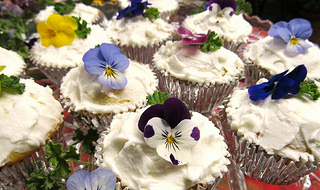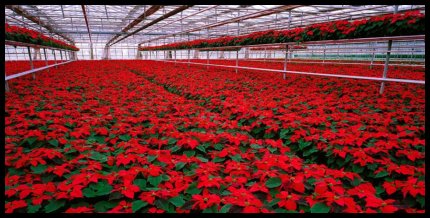over life-threatening illness and the power of healing through gardening.
Americans buy over 75 million poinsettias during the holiday season
In Praise of Poinsettias
by Chris Winslow
No Christmas holiday decorations for a home are complete without the
poinsettia.
This colorful plant (Euphorbia pulcherrima) is native to southern Mexico
and Central America, and was used once as a fever medicine by the
ancient Aztecs.
It is known as nochebuena in Mexico, and would have stayed in the jungle
if it wasn’t for the efforts of Joel Roberts Poinsett (1770 – 1851), the first
U.S. ambassador to Mexico.
Poinsett was an amateur botanist. One day in 1828 the ambassador decided
to bring this lovely plant back to his home in South Carolina. Here he started
propagating the ‘poinsettia’ and sent some plants to friends and colleagues
around the country.
The poinsettia’s leaves and stems grow when the days grow long, and begins
to bloom as the days become short in the fall.
The flowering part consists of large colored leaves, called bracts, and the cy-
anthia flowers.
In the native plant, the bracts and flowers are quite small. Thanks to hybrid-
ization the colorful leaves of the modern poinsettia have become much larger
and you now have a multitude of colors to choose from.
We have poinsettia varieties with names like angelica, jingle belles, celebrate,
V-14 glory, freedom, and subjibe.While the most popular color for the Christmas
season is red, other colors such as pink, salmon, white and bicolor are available.
This plant is pretty easy to care for: put it in a well-lit location, and give it
some water when it’s dry. Avoid leaving its roots standing in water. (It will die.)
Ideal temperatures are a 70 degree day and a slightly cooler night. If it gets too
hot, its bloom time will be shortened.
Come springtime, you can keep your poinsettia as a potted plant, or plant it
outside in a very protected, sunny location. With any luck, and with a very
late cold spell in fall 2009, you might get a few blooms.
Americans buy over 75 million poinsettias during the holiday season, making
them the best selling potted plant in the country.
I’m often asked if they are poisonous. From what I have read, poinsettias are
not toxic. A study from Ohio State University showed that a 50 pound child
eating 500 leaves might get a slight tummy ache. The American Society of
Florists has stated that no other plant has been tested more than poinsettias.
Happy Holidays Everyone!



